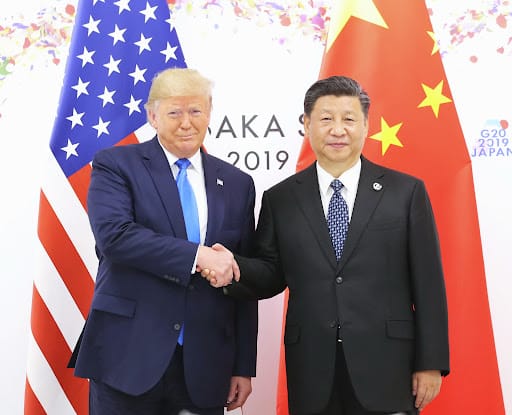By John C. Azu
The ports in Shanghai, Ningbo, Guangzhou, Qingdao, and Hong Kong are bursting at the seams. Chinese goods can no longer be sold in the United States at a profitable rate. It is a critical situation in the global economic dynamic that President Donald Trump has introduced with his tariff war. This has shifted the balance of the hitherto multilateral, rules-based international system piloted by the World Trade Organisation (WTO). As the trade war escalates, China is expected to dig deep into its strategic alternatives forged across millennia for a day like this.
The trade war, which began after a sparring 25% tariff on Mexico, Canada and China if they fail to control cross-border drugs fentanyl, Trump on February 1, 2025, announced a 10% flat tariff on all goods coming from outside the US, particularly China, which suffered a hit on $450 billion worth of goods. China retaliated on February 10 with a 15% tariff on coal and liquefied natural gas and a 10% tariff on oil and agricultural goods coming from the US, worth $20 billion. On March 4, Trump again imposed an increase to 20%; China retaliated from March 10 with 15% tariff on US agricultural products such as chicken, wheat, corn and cotton, as well as 10% tariff on US sorghum, soybeans, pork, beef, aquatic products, fruits, vegetables, and dairy products. On April 2, while declaring it a “liberation day”, Trump added a 34% “reciprocal tariff” on top of the extant 20% tariff on Chinese goods, making it 54%.
However, the war took a horrifying turn on April 10 when the US imposed a 104% tariff on Chinese goods. China hit back with an 84% tariff on US goods arriving in China. On April 11, the US raised theirs to 145% on Chinese goods, which China also responded to with their 125% tariff. The war appears poised for a ‘who will blink first’ scenario between the two largest economies.
With the intractable situation, China’s followers expect the country to reach deep into its most reserved bag of tricks. When the US imposed the sparring 25% tariff on imports from Canada, Mexico and China, it seemed a universal bill, but not many deduced that China was all along the target. It seemed clearer during President Emmanuel Macron’s visit to Washington in February, where he tried to persuade Trump to concentrate on China and to spare the European Union, his dose of protectionism.
China: A resilience built over millenia
With over 5,000 years of history, Chinese mythology and philosophy are replete with solutions coming through from within when situations appear hopeless and irredeemable. In Buddhism, Confucianism and Taoism, there are time-honoured contextual pathways through difficulty; the concept of the Yue Lao speaks to internal strength and self-reliance. During the Qing Dynasty in the 1600s, the Chinese realism anchored on its self-awareness as the centre of the earth or the “Middle Kingdom”, compelled it to embark on a closed-door policy that enhanced its stability and prosperity, which then required a Western coalition to break and force China to open its borders for international trade in the 19th century.
China anticipated the appearance of doomsday when, in January 2021, it enunciated its “dual circulation” or “double dynamic” policy. It was during the 14th plenum of the two sessions of the National People’s Congress (NPC) and the National Committee of the Chinese People’s Political Consultative Conference (CPPCC). The policy is a shift of perspective to a more inward, self-reliant mode. It is perhaps the most appropriate step towards building a resilient economy in the face of global uncertainties.
The policy of ‘dual circulation’ or ‘double dynamic’ is intended to achieve greater focus on the domestic production, distribution, and consumption of goods and services. In effect, development projects, manufacturing, innovation and digital upgrades are being anchored on the domestic economy without abandoning the international front – that is, new friendly market frontiers. Essentially, the plan is for the inward and outward flows to reinforce each other.
This new Chinese shift in global trade cannot only be viewed with rose-tinted lenses. It is a path strewn with many hiccups. China is still a developing country mired by challenges of income inequality and air pollution. The country is on the cusp of AI-driven innovations and a high-quality development trajectory, all aimed at building a moderately prosperous society.
It needs saying that necessity had laid it upon Chinese policy makers to depart from the 30-year ‘international circulation’ started under Deng Xiaoping. This new path had been foreshadowed by several global events. The 2008 global economic recession which exposed the vulnerability of the export-driven model, the trade war with the US under President Donald Trump’s first tenure, the propaganda that greeted the COVID-19 pandemic and the introduction of 5G technology, all impelled this vast country to attempt to take its destiny in its own hands by this twist to rebalance growth towards domestic demand.
New market frontiers
On the new market frontiers, China has embarked on cultivating its closest neighbours, in a shift that could significantly reshape the geopolitical landscape of East Asia. The economic dialogue held between China, Japan, and South Korea on March 30 was the first in five years. The dialogue is aimed at regional trade cooperation, which could erode the United States’ strategic influence in the Indo-Pacific region, a pointer that Trump may have made a pig’s breakfast of his Make America Great Again mantra.
China could also profit from Trump’s steep tariffs on Southeast Asian countries like Vietnam, Malaysia and Cambodia as President Xi Jinping begins a state visit there from April 14-18. With these countries facing 46%, 49% and 24% tariffs respectively, they will fancy new trading opportunities from China. Besides, the Eastern European bloc is all too happy to reengage its ancient trade relations with China. In addition, there are other ancillary markets and production hubs for China in Africa and Latin America.
Overall, the integration with the Asian markets complemented with the Regional Comprehensive Economic Partnership (RCEP), which is a free trade zone comprising 10 members of the Association of Southeast Asian Nations (ASEAN), plus China, Japan, South Korea, Australia and New Zealand, will mutually support productivity and stability. This will reinforce China’s dual circulation strategy by trading with its neighbours in a zone that makes up one-third of the world population and 29% of global gross domestic product.
Ultimately, it is the calibration of the domestic market, the boost in consumption culture that will save the Chinese vibrant manufacturing economy. One, the market is huge with 1.4 billion people. This market was largely untapped, perhaps due to factors such as inadequate data and disposable income. China is today leading the world in big data and digital economy, which is sure to rub off on this policy. Previously, the Chinese economy was not as credit-driven as the US. With big data and biometric banks across the country, including the countryside, many Chinese can have access to more consumer and luxury goods, with flexible payment systems. A plus to all these is that talents and skills are abundant, even as the cost of production remains competitive.
Further, the government’s all-encompassing poverty alleviation project, which by December, 2020 saw millions of citizens in 832 national-level counties lifted out of poverty and provided with sustainable livelihoods, had seen a generally boosted citizens’ spending ability. China reached a purchasing power parity of above 4.2 LCU in 2019. As of November 2020, disposable income for rural dwellers in China was ¥27, 540 which is $2,463.55, while that of urban dwellers was ¥64, 084 which is about $9,868.34. With this, a lot of manufacturing companies in China are in for a big surge in consumer demand with enhanced digital and e-commerce development.
Furthermore, China has a world-class infrastructure. After years of investing in infrastructure such as high-speed train lines, power, healthcare, education and rural to urban connectivity, China has been reaping the dividends. The country has since redirected its focus to high-quality development, setting the pace in high-tech innovations, manufacturing and carbon neutrality. This, no doubt, will continue to make the country an attractive investment destination.
In conclusion, China’s strategic alternative policy choices are good enough, if not better than those of its competitors. China is leading an alternative path that will wean the country and much of East Asia off the US, the same way it developed chip-making sufficiency after the US snub. With a well-developed domestic market reinforced by global demands, the vast, peaceful country is set to further accelerate its economic development and the prosperity of its people. Indeed, as both nations battle, there must be a realisation that in a closely interdependent world, countries would lose more by staying apart than they would by coming together.
Azu is an Abuja-based journalist and the author of the book: “Contemporary Legal Cooperation: China and Africa – A Comparative Survey of Legal Studies”.

